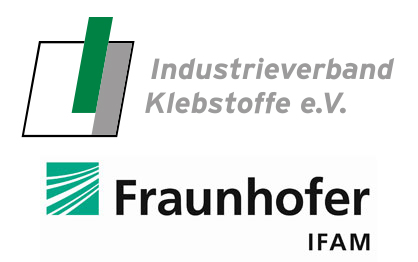4.6.2 Adhesives which harden on drying
Adhesives which harden on drying: Solvent-containing wet adhesives
General description
- Thermoplastics, dissolved in an organic solvent
- Hardening via evaporation of the solvent
A variety of different thermoplastic materials are used to manufacture solvent-based adhesives
- Polyurethanes
- PVAc (polyvinyl acetate)
- Natural rubbers
- Acrylates
Physical properties in the as-supplied state:
- Thin liquids to viscous liquids
Processing properties:
- Manual, semi-automated or fully automated processing
- For preferred equipment contact the adhesive manufacturer
- Processing temperature: room temperature
- Normal contact pressure
- Adhesive film thickness: 0.2 – 0.5 mm
- Good wetting properties on many surfaces
- On joining the substrates, the adhesive film still contains a considerable amount of solvent (“wet”; substrates must be permeable for the solvent)
- All solvent must escape from the joint during the hardening process
- The solvent must not attack the substrates (risk of stress cracking for some plastics)
- Suitable for bonding various plastics or for diffusion bonding (cold welding) of soluble plastics/thermoplastics (e.g. PVC, PC, PMMA)
- Secure until the bonded joint has reached hand strength
- Take relevant measures for health and safety at work and environmental protection (General: see Section 7; Details: see safety data sheet)
Diffusion bonding (also called solution welding or cold welding):
 |
 |
 |
| 1. Application of the solvent or the solvent-containing adhesive to both plastic surfaces |
2. Swelling of the surfaces; Dissolution and release of polymermolecules |
3. Under pressure, formation of a diffusion zone containing polymermolecules and escape of the solution can be recovered again by physical methods (e.g. distillation, crystallisation, adsorption, etc.).’]solvent[/simple_tooltip] → continuouscohesion zone |
Typical properties of the hardened adhesives:
- Wide selection of raw materials – range of different properties
- Low to medium strength
- Low thermal stability, temperature for continuous use below the softening temperature
Points to heed:
- Substrates must not be attacked by the solvent in the adhesive (e.g. risk of stress cracking for some plastics)
- At least one substrate must be permeable to the solvent
If you have questions about the product then see the technical data sheet or contact the adhesive manufacturer
Adhesives which harden on drying: Dispersion adhesives
General description
- Polymer particles distributed in water (dispersed)
- Harden to become thermoplastics or elastomers
- Due to lack of organic solvents, dispersion adhesives are marketed as alternative eco-friendly adhesives
A variety of different thermoplastic materials are used to manufacture dispersion adhesives.
The most important are:
Ethyl vinyl acetate copolymer (EVA)
PVAc (polyvinyl acetate)
Acrylates
Polyurethanes
Natural rubbers
Physical properties in the as-supplied state:
- Consistency: thin liquids to viscous liquids
Processing properties:
- Manual, semi-automated or fully automated processing
- For preferred equipment contact the adhesive manufacturer
- Processing temperature: room temperature
- Normal contact pressure
- Adhesive film thickness: 0.2 – 0.5 mm
- Slow hardening via the evaporation of water
- Formation of a transparent film
- Heed the minimum temperature for film formation
- Secure until the bonded joint has reached hand strength
- Take relevant measures for health and safety at work and environmental protection (General: see Section 7; Details: see safety data sheet)
Difference: Solution – Dispersion
| A solution is a homogenous mixture comprising one or more substances dissolved in a solvent. |  |
| A dispersion is a heterogeneous mixturecomprising at least two substances that cannot dissolve in one another or can barely dissolve in one another. |  |
Typical properties of the hardened adhesives:
- Low to medium strength
- Maximum temperature for continuous use: ca. 100°C
- Sensitive to moisture
Points to heed:
- At least one substrate must be permeable to the solvent (water here)
- Substrates must not be attacked by the solvent (here water) in the adhesive
If you have questions about the product then see the technical data sheet or contact the adhesive manufacturer
Adhesives which harden on drying: Contact adhesives
General description:
- Thermoplastics, sometimes also wide-meshed elastomers, usually dissolved in organic solvents
Physical properties in the as-supplied state:
- Viscous liquids
Processing properties:
- Manual, semi-automated or fully automated processing
- For preferred equipment contact the adhesive manufacturer
- Processing temperature: room temperature
- High contact pressure necessary
- Adhesive film thickness: 0.2 – 0.5 mm
- Apply to both substrates
- Heed the minimum drying time / evaporation time, during which virtually all the solvent must evaporate; on touching it must be apparently dry: Finger test
- Join the substrates under high pressure (the pressure and not the duration of the pressure is decisive for a good result)
- Hand strength is reached immediately; then the strength slowly increases to the final strength
- Take relevant measures for health and safety at work and environmental protection (General: see Section 7; Details: see safety data sheet)
Typical properties of the hardened adhesives:
- Wide selection of raw materials – range of different properties
- Low to medium strength
- Maximum temperature for continuous use: ca. 100°C
Finger test:
- Used to check observance of the minimum drying time / evaporation time for contact adhesives
- Gently touch the adhesive with the finger knuckle or grease-free fingertip: The adhesive should feel dry and not stick to the finger
- This test must not contaminate the adhesive!
Points to heed:
- The finger test must not contaminate/damage the adhesive film
- Substrates must not be attacked by the solvent in the adhesive. Care must be taken with plastics that are prone to stress cracking.
- Apply the adhesive to both substrates, heed the evaporation time and then join under high pressure
If you have questions about the product then see the technical data sheet or contact the adhesive manufacturer



